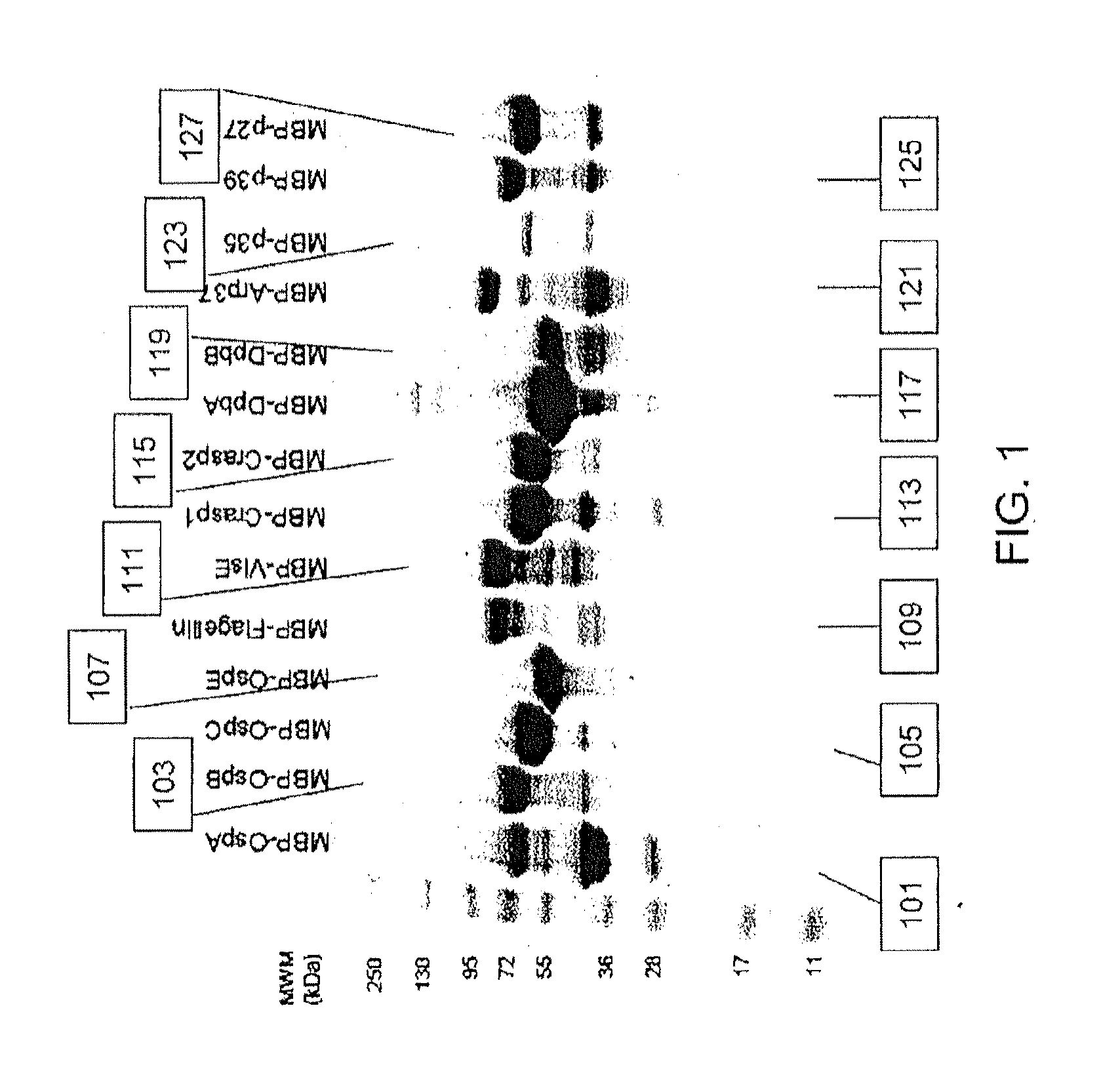Proteins and method for detection of lyme disease
a lyme disease and protein technology, applied in the field of lyme disease detection methods, can solve the problems of not being diagnosed, unable to detect, and unable to treat, and achieve the effect of accurate detection of ld, time-saving, and cost-effectiv
- Summary
- Abstract
- Description
- Claims
- Application Information
AI Technical Summary
Benefits of technology
Problems solved by technology
Method used
Image
Examples
example 1
Selection, Design and Production of Antigens for Borrelia-Specific Antibody Detection
[0083]B. burgdorferi genomic DNA (Catalog #35210D-5) was obtained from the ATCC and fourteen (14) B. burgdorferi-specific proteins representative of the in vivo life cycle post infection: OspA, OspB, OspC, OspE, Flagellin, VlsE, Crasp-1, Crasp-2,DbpA, DbpB, Arp37, p35, p39 and p27 were selected to be included in the assay design. Gene-specific primers for the PCR-based amplification of individual bacterial genes were designed and synthesized. Amplified genes were inserted into a modified pMa1C2X vector (NEB #E8200S, New England Biolabs) by ligation independent cloning. Cloned inserts were verified by DNA sequencing and confirmed vectors were transformed into the E. coli expression strain BL21(DE3)pLysS. All fourteen MBP / B. burgdorferi fusion proteins were successfully expressed in E. coli upon IPTG induction (FIG. 9).
[0084]Cells from induced two liter cultures were harvested by centrifugation and ly...
example 2
Assay Optimization
[0086]Initial investigations to determine assay-specific parameters included the evaluation of human LD positive serum reactivity in a slot blot assay. Recombinant MBP / B. burgdorferi antigens as well as recombinant MBP at known concentrations ranging up to 1 μg were individually loaded into separate slots and adsorbed onto a nitrocellulose membrane overnight at 4° C. The membrane was rotated by 90° prior to application of 1:100 diluted serum from clinically characterized individual donors (n=12), obtained from SeraCare Diagnostics (Milford, Mass.), across all 14 B. burgdorferi antigens (OspA, OspB, OspC, OspE, VlsE, CRASP-1, CRASP-2, DbpA, DbpB, Flagellin, Arp37, P27, P35, and P39). Sera were incubated for 2 h at 4° C. prior to washing of the membrane and application of either HRP-conjugated anti-human IgG Fc or HRP-conjugated anti-human IgM Fc5μ antibodies. Results obtained from individual serum donors after substrate addition showed reactivity to specific B. burg...
example 3
Application of the Assay to Measure Borrelia-Specific Antibodies in Human Serum and Comparison with Current Assays Available on the Market
[0090]LD positive human sera were obtained from the CDC (n=35) and Tufts University (n=12). Samples from the CDC were accompanied by written results of a clinical exam as well as bioMérieux ELISA and MarBlot IgG and IgM WB results. LD positive human sera and negative control sera (n=5) were analyzed to demonstrate detection of strip immobilized B. burgdorferi antigens by antibodies present in sera of patients diagnosed with LD. IgG and IgM test strips were modified to receive sera premixed with liquid gold-labeled recombinant B. burgdorferi antigens and processed using all 52 sera. Antibody reactivity resulted in gold deposition for band visualization and was recorded after 20 min while wet and after 18 h when dried. No change in band reactivity between the two evaluation time points was noted. All LD positive sera showed significant reactivity to...
PUM
| Property | Measurement | Unit |
|---|---|---|
| molecular weight | aaaaa | aaaaa |
| molecular weight | aaaaa | aaaaa |
| molecular weight | aaaaa | aaaaa |
Abstract
Description
Claims
Application Information
 Login to View More
Login to View More - R&D
- Intellectual Property
- Life Sciences
- Materials
- Tech Scout
- Unparalleled Data Quality
- Higher Quality Content
- 60% Fewer Hallucinations
Browse by: Latest US Patents, China's latest patents, Technical Efficacy Thesaurus, Application Domain, Technology Topic, Popular Technical Reports.
© 2025 PatSnap. All rights reserved.Legal|Privacy policy|Modern Slavery Act Transparency Statement|Sitemap|About US| Contact US: help@patsnap.com



